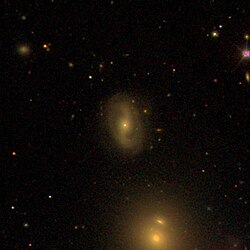
KNOWPIA
WELCOME TO KNOWPIA
Summary
NGC 998 is a spiral galaxy in the constellation Cetus. It is estimated to be 294 million light years from the Milky Way and has a diameter of approximately 90,000 ly. Together with NGC 997, it forms a gravitationally bound pair of galaxies. NGC 998 was discovered by astronomer Albert Marth on 10 November 1863 using a 48-inch telescope.[4][5][6]
| NGC 998 | |
|---|---|
 SDSS image of NGC 998 | |
| Observation data (J2000 epoch) | |
| Constellation | Cetus |
| Right ascension | 02h 37m 16.50891s[1] |
| Declination | +07° 20′ 08.7169″[1] |
| Redshift | 0.02184[2] |
| Heliocentric radial velocity | 6476 km/s[2] |
| Distance | 303.7 ± 21.4 Mly (93.11 ± 6.56 Mpc)[3] |
| Apparent magnitude (B) | 14.6[2] |
| Absolute magnitude (V) | -23.46 +/- 0.51[2] |
| Characteristics | |
| Type | S?[2] |
| Other designations | |
| MCG +01-07-015, PGC 9934[2] | |
See also edit
References edit
- ^ a b Brown, A. G. A.; et al. (Gaia collaboration) (August 2018). "Gaia Data Release 2: Summary of the contents and survey properties". Astronomy & Astrophysics. 616. A1. arXiv:1804.09365. Bibcode:2018A&A...616A...1G. doi:10.1051/0004-6361/201833051.
- ^ a b c d e f "NGC 998". SIMBAD. Centre de données astronomiques de Strasbourg. Retrieved 2020-06-03.
- ^ "Results for object NGC 0998 (NGC 998)". NASA/IPAC Extragalactic Database. California Institute of Technology. Retrieved 2020-06-03.
- ^ "Revised NGC Data for NGC 998". spider.seds.org. Retrieved 2020-03-24.
- ^ "Your NED Search Results". ned.ipac.caltech.edu. Retrieved 2020-03-24.
- ^ Ford, Dominic. "The galaxy NGC 998 - In-The-Sky.org". in-the-sky.org. Retrieved 2020-03-24.
External links edit
- Media related to NGC 998 at Wikimedia Commons


